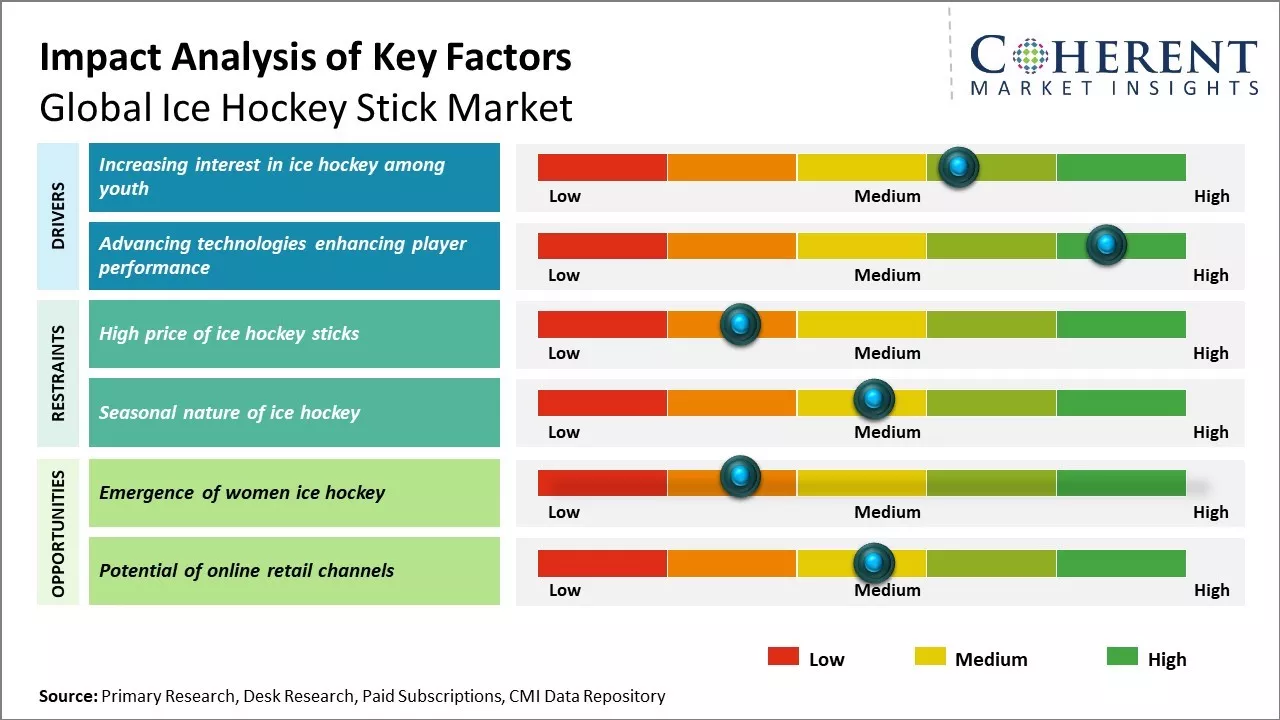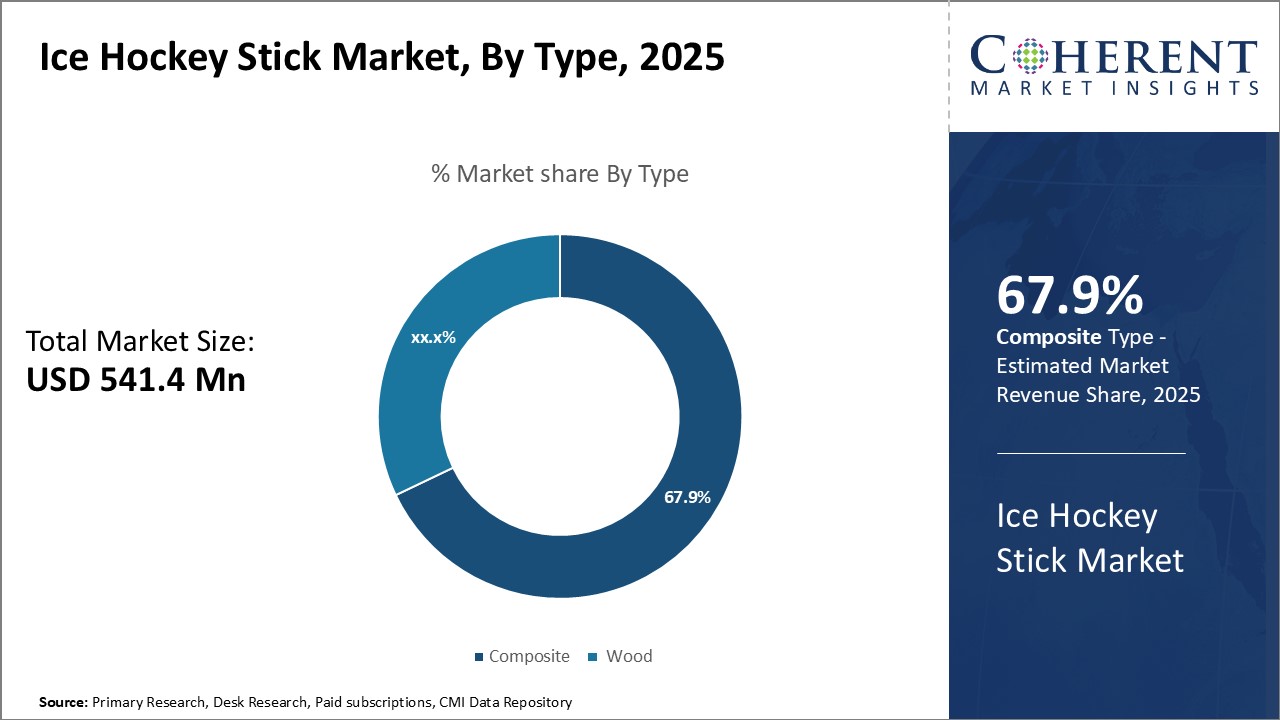Ice Hockey Stick Market Size and Trends
Global ice hockey stick market is estimated to be valued at USD 541.4 Mn in 2025 and is expected to reach USD 727.4 Mn by 2032, exhibiting a compound annual growth rate (CAGR) of 4.3% from 2025 to 2032.

Discover market dynamics shaping the industry: Download Free Sample
Global ice hockey stick market has been witnessing growth over the past few years due to increasing popularity of ice hockey globally especially in European and North American countries. Global ice hockey stick market is expected to witness a positive growth trend over the forecast period due to rising number of ice hockey players worldwide. The advancement in stick technology innovating stick design and materials to provide improved control and shooting power can boost demand for these sticks. However, factors such as high equipment cost limiting market from players in lower income countries and seasonal nature of ice hockey can hamper the market growth.
Increasing interest in ice hockey among youth
The popularity of ice hockey is steadily rising among youth in North America. More children are taking up the sport at younger ages and continuing to play competitively through high school and college. Many cities and towns are investing in community ice rinks to provide better accessibility for local youth to learn to skate and play organized hockey leagues. With the sport gaining more mainstream coverage on television through prominent leagues like the NHL, young fans are becoming intrigued by fast-paced games and skilled players. These people aspire to emulate the actions of their favorite professional athletes by spending hours on the rink practicing shots, passes, and skating techniques. Parents also want to encourage an active hobby for their kids that develops important life skills. Along with physical conditioning, ice hockey cultivates teamwork, strategy, sportsmanship, and time management abilities. It provides a structured activity outside of school that keeps children socially engaged with peers. Investing in entry-level youth ice hockey equipment including sticks, gloves, skates and other gear has become more financially justifiable for families who believe the sport offers lasting developmental benefits. Equipment manufacturers have also responded to growing demand by designing and marketing products specifically tailored for developing players at beginner levels. This includes lighter-weight sticks that are easier for young wrists and swings to control.
Market Concentration and Competitive Landscape

Get actionable strategies to beat competition: Download Free Sample
Advancing technologies enhancing player performanceIce hockey stick design and construction technologies have undergone rapid advancement in recent years. Manufacturers are dedicating large research and development budgets towards innovating stick shapes, layups, core materials and other performance factors based on feedback from professional athletes and data analytics. These innovations directly improve on-ice outcomes for players, and this stimulates new equipment purchases. Carbon fiber has become a primary material for shafts and blades due to its ideal strength-to-weight ratio and vibration dampening properties. It allows for ultra-lightweight sticks that feel remarkably stiff and responsive on shots. Additional enhancements like variable stiffness blades and reinforced heel/tip areas further promote shot velocity and accuracy. Advanced graphics and virtual prototyping tools also enable hyper-realistic testing of new design concepts before physical production. This expedites the time to market for cutting edge stick models.
Key Takeaways from Analyst:
Global ice hockey stick market growth is driven by rising popularity of hockey globally. North America remains the dominant region due to strong participation in hockey at youth and amateur levels in U.S. and Canada. Europe is expected to witness higher growth, owing to efforts by national federations to promote the game.
Traditional wood sticks have sizable market share, growing preferences of players for superior performance gives advantage to composite materials in sticks. Backlash from traditionalists concerned about changing the character of the sport act as a restraint on faster adoption of advanced materials.
Youth segments across regions are most lucrative as kids replace sticks more frequently than adults. Participation of private labels and local manufacturers create pricing competition and more affordable options to make hockey accessible to aspiring players.
Market Challenge: High price of ice hockey sticks
The high price of ice hockey sticks is significantly restraining the growth of the global ice hockey stick market. Ice hockey is an expensive sport that requires a considerable initial investment in protective gear and equipment. A high-quality ice hockey stick suitable for competitive play can often retail for well over USD 100, putting the equipment outside of financial reach for many potential new players. This price barrier prevents many from even starting to play the sport and negatively impacts the potential expansion of the player base. The sport overall also has an image of exclusivity due to these equipment costs that dissuades some from participating. Parents may be reluctant to spend hundreds of dollars outfitting their child if the sport does not seem accessible to all economic backgrounds. Without a consistent influx of new and younger players, the market for ice hockey sticks and other gear will struggle to sustain long-term growth. Equipment manufacturers are in a difficult position as well, as dropping prices too far could damage brands or product quality. However, prices that remain extremely high also constrain how many customers they can reach.
Market Opportunity: Emergence of women ice hockey
The emergence of women's ice hockey provides a tremendous opportunity for growth in the global ice hockey stick market. As participation rates for women's ice hockey continue to rise significantly around the world, especially in North America and northern Europe, the demand for high-quality hockey sticks tailored for women will also rise accordingly. Women's ice hockey has grown immensely in popularity over the past decade alone.

Discover high revenue pocket segments and roadmap to it: Download Free Sample
Insights, By Type: Gains in performance and durability drives the composite segment growth
Among type, composite segment is estimated to contribute the 67.9% share of the ice hockey stick market in 2025. Composite materials offer superior performance attributes as compared to wood. These provide enhanced flexibility, thus, allowing players to take powerful shots with pinpoint accuracy. The lightweight yet rigid construction of composite also allows for faster puck velocity. Composite sticks absorb more shock and impact as compared to wood, thus, reducing hand fatigue over long playing periods. These performance gains have increased shot power and accuracy among players, helping them score more goals. Composite sticks are also significantly more durable than traditional wood sticks. The layered construction of fibers, resins and cores makes these resistant to cracking or damage from routine stick handling and shooting. This translates to a longer lifespan before replacement is needed. In contrast, wood sticks are prone to splintering or breaking with regular on-ice impacts. The reduced need for frequent replacement lowers the overall ownership cost of composite sticks over time. Manufacturers have also continuously innovated with new composite materials and designs. Advanced proprietary materials now available deliver quantifiable improvements in performance metrics. Prominent brands extensively market these innovations to showcase technology leadership. Their endorsement by elite professional players further boosts demand. Trickling down, recreational players are also increasingly opting for composites to gain similar performance benefits. This success has come at the expense of wood sticks, whose market share continues to decline steadily. Barring unforeseen technological disruptions, composites look set to cement their position as the material of choice across the ice hockey stick market.
Insights, By Distribution Channel: Offline segment contribute the highest market share
Among distribution channel, offline segment is estimated to hold 72.1% share of ice hockey stick market in 2025. Hockey is a specialized sport that requires proper fittings for sticks and protective gear, and thus, offline stores provide the hands-on experience needed to select the right equipment. Experienced sales staff can analyze attributes like wrist size, hand preference, shooting style and fit recommendations. This personalized service experience translates to higher customer satisfaction levels as compared to online purchases. Many players also prefer to test sticks in-store before finalizing their purchase. This allows comparing different brands, flex patterns, lie angles and weight distributions by trial usage. The opportunity to demo products on the shop floor builds confidence in the final selection of the product. Such extensive trial-testing is challenging with online shopping alone. Offline retailers also stock a diverse range of product options from various manufacturers under one roof. This consolidates research and enables one-stop shopping convenience. In contrast, online portals may lack or delay certain product availability. Several retailers offer trade-in or equipment swap programs during upgrades, thus, such value-added services boost in-store loyalty over time. Established brick-and-mortar chains have also rapidly amplified their multi-channel capabilities. These now seamlessly bridge the online and offline experience through services like online reservations, buy-online pickup-in-store, product reviews and virtual consultations. These multi-touchpoint integrations leverage the respective strengths of physical and digital worlds to cement their market standing.
Regional Insights

Need a Different Region or Segment? Download Free Sample
North America has been the dominant region in the global ice hockey stick market with estimated 35.1% share in 2025. The U.S. and Canada are two of the biggest hockey playing nations globally, with both countries having strong domestic leagues and national teams that enjoy widespread popularity. Both nations have a long history and culture associated with ice hockey which has helped develop a robust ice hockey infrastructure over the decades. Major ice hockey stick manufacturers are headquartered in this region, thus, allowing them to cater efficiently to the local demand. Provided the large player base, retailers in this region stock a wide variety of ice hockey sticks targeting different player segments. North American players have an advantage of easily accessing a diverse range of sticks through local channels.
Asia Pacific region has emerged as the fastest growing market for ice hockey sticks globally in recent years. Several countries in East Asia and Southeast Asia such as China, Japan, Malaysia and Thailand have witnessed rising interest in ice hockey among young athletes. Many national federations have invested in grassroots development programs to nurture talent at a young age. The exposure through international events broadcasted locally has fueled passion for the sport. With increasing participation in ice hockey, there has been huge demand for gear and equipment including sticks in Asia Pacific region. Several global manufacturers have responded by setting up local manufacturing and distribution operations to cater to regional demand. This has made ice hockey sticks more accessible at competitive prices. The availability of affordable yet high-quality sticks is expected to further drive the market growth inAsia Pacific.
Market Report Scope
Ice Hockey Stick Market Report Coverage
| Report Coverage | Details | ||
|---|---|---|---|
| Base Year: | 2024 | Market Size in 2025: | USD 541.4 Mn |
| Historical Data for: | 2020 To 2024 | Forecast Period: | 2025 To 2032 |
| Forecast Period 2025 to 2032 CAGR: | 4.3% | 2032 Value Projection: | USD 727.4 Mn |
| Geographies covered: |
|
||
| Segments covered: |
|
||
| Companies covered: |
Mylec, Inc., Canadian Tire Corporation Limited, BISON HOCKEY STICKS, vaughn hockey, BAUER Hockey, LLC, Hans Raj Mahajan, ALFA HOCKEY, DRH Sports., Falk Hockey, Hyoung Carbon Fiber Products Co., Ltd, COLT Hockey, Rival Hockey, LM Hockey, RK Mahajan, Vinex Plastic |
||
| Growth Drivers: |
|
||
| Restraints & Challenges: |
|
||
Uncover macros and micros vetted on 75+ parameters: Get instant access to report
Ice Hockey Stick Industry News
- In January 2024, IQST - iQSTEL CEO announced the acquisition of QXTEL as Hockey Stick Growth Curve Event
- In 2022, CCM Hockey launched limited edition gold stick in collaboration with Sarah Nurse to celebrate her success and giveback to charity
- Bauer AG5NT, a new hockey stick, was launched in 2022 as part of Bauer's elite stick lineup
- In 2021, Sigmatex renewed partnership with CCM Hockey
*Definition: The ice hockey stick market caters to professional and amateur ice hockey players. It includes different types of hockey sticks designed for various playing positions and styles. Major products in this market include defenseman sticks, forward sticks, goalie sticks, and specialty/crossover sticks. Key factors such as flex, lie, kick point, blade pattern, shaft material and construction are customized to suit individual player needs. Major companies compete on innovation, performance, brand recognition and endorsements to dominate this niche sporting goods market.
Market Segmentation
- Type Insights (Revenue, USD Mn, 2020 - 2032)
- Composite
- Wood
- Distribution Channel Insights (Revenue, USD Mn, 2020 - 2032)
- Online
- Offline
- Regional Insights (Revenue, USD Mn, 2020 - 2032)
- North America
- U.S.
- Canada
- Latin America
- Brazil
- Argentina
- Mexico
- Rest of Latin America
- Europe
- Germany
- U.K.
- Spain
- France
- Italy
- Russia
- Rest of Europe
- Asia Pacific
- China
- India
- Japan
- Australia
- South Korea
- ASEAN
- Rest of Asia Pacific
- Middle East & Africa
- GCC Countries
- Israel
- Rest of Middle East & Africa
- North America
- Key Players Insights
- Mylec, Inc.
- Canadian Tire Corporation Limited
- BISON HOCKEY STICKS
- vaughn hockey
- BAUER Hockey, LLC
- Hans Raj Mahajan
- ALFA HOCKEY
- DRH Sports.
- Falk Hockey
- Hyoung Carbon Fiber Products Co., Ltd
- COLT Hockey
- Rival Hockey
- LM Hockey
- RK Mahajan
- Vinex Plastic
Share
Share
About Author
Yash Doshi is a Senior Management Consultant. He has 12+ years of experience in conducting research and handling consulting projects across verticals in APAC, EMEA, and the Americas.
He brings strong acumen in helping chemical companies navigate complex challenges and identify growth opportunities. He has deep expertise across the chemicals value chain, including commodity, specialty and fine chemicals, plastics and polymers, and petrochemicals. Yash is a sought-after speaker at industry conferences and contributes to various publications on topics related commodity, specialty and fine chemicals, plastics and polymers, and petrochemicals.
Missing comfort of reading report in your local language? Find your preferred language :
Transform your Strategy with Exclusive Trending Reports :
Frequently Asked Questions
EXISTING CLIENTELE
Joining thousands of companies around the world committed to making the Excellent Business Solutions.
View All Our Clients
